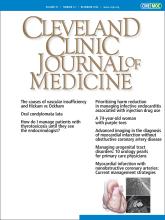ABSTRACT
From 6% to 8% of patients who present with myocardial infarction have no evidence of obstructive coronary artery disease on angiography. This subgroup tends to be younger, and more of them are women. This review highlights a proposed algorithm to identify the underlying cause of myocardial infarction with nonobstructive coronary arteries (MINOCA). We emphasize the need for a collaborative approach in diagnosing and managing MINOCA to improve patient outcomes, advocating for a standardized diagnostic pathway that incorporates cardiac magnetic resonance imaging and comprehensive clinical evaluation to tailor treatments effectively.
- Copyright © 2024 The Cleveland Clinic Foundation. All Rights Reserved.

Clicking the link below will connect you to begin the credit-claiming process for CME and MOC. After clicking on the link, scroll to the bottom of the page and click on “Complete the CME/MOC Process.” You will need your myCME login information to access this.
- Kevin G. Buda, DO
- Sanjoyita Mallick, DO⇑
- Address:
Sanjoyita Mallick, DO, Department of Medicine, Hennepin Healthcare, 701 Park Avenue, Minneapolis, MN 55415-1829; Sanjoyita.mallick{at}hcmed.org
- Louis P. Kohl, MD
ABSTRACT
From 6% to 8% of patients who present with myocardial infarction have no evidence of obstructive coronary artery disease on angiography. This subgroup tends to be younger, and more of them are women. This review highlights a proposed algorithm to identify the underlying cause of myocardial infarction with nonobstructive coronary arteries (MINOCA). We emphasize the need for a collaborative approach in diagnosing and managing MINOCA to improve patient outcomes, advocating for a standardized diagnostic pathway that incorporates cardiac magnetic resonance imaging and comprehensive clinical evaluation to tailor treatments effectively.
- Copyright © 2024 The Cleveland Clinic Foundation. All Rights Reserved.






